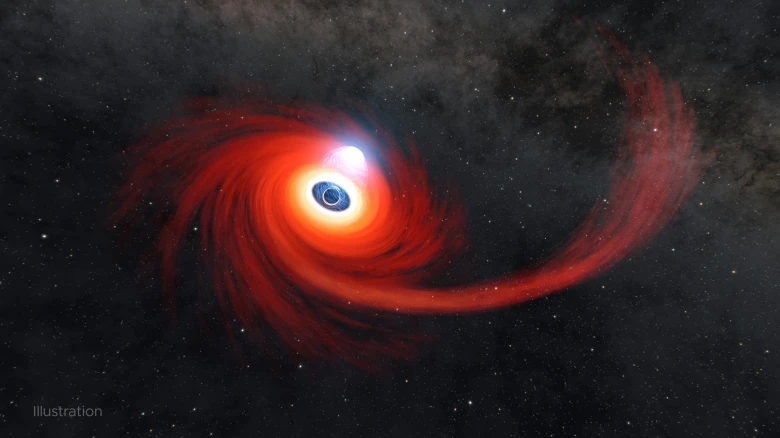Supermassive Black Hole Spotted Eating Sun-Like Star in Nearby Galaxy – Black holes, cosmic objects famed for their appetites, typically devour stars that come too close to them in one large gulp, annihilating them with their immense gravitational force. However, some people like to munch rather than overeat.
According to the researchers, they have observed a supermassive black hole at the center of a relatively nearby galaxy as it consumes material equal to about three times Earth’s mass each time the star makes a close pass on its elongated oval-shaped obit.
Black holes are very dense objects with so much gravity that not even light can escape.
The star is approximately 520 million light years away from our solar system. A light year is the distance traveled by light in a year, which is 5.9 trillion miles (9.5 trillion km). A supermassive black hole at the center of a spiral-shaped galaxy was witnessed devouring it.
As far as black holes go, this one is quite small, with a mass estimated to be a few hundred thousand times that of the sun. Sagittarius A*, the supermassive black hole at the heart of our galaxy, has approximately 4 million times the mass of our sun. Other galaxies have supermassive black holes that are hundreds of millions of times the mass of the sun.
Most galaxies have such black holes at their cores, and their surroundings can be among the most violent in the cosmos.
The majority of the data used in the current study came from NASA’s orbiting Neil Gehrels Swift Observatory.
Every 20 to 30 days, the star was detected orbiting the black hole. At one end of its orbit, it approaches the black hole close enough to have some material from its stellar atmosphere pulled away, or accreted, each time it passes — but not so close that the entire star is shredded. This is known as a “repeating partial tidal disruption.”
Also see: Elemental Releasing on Disney+ Hotstar on September 13 in India
Meta Teams With LG On a Mixed Reality Headset to Compete with Apple’s Vision Pro
The star material that falls into the black hole heats up to approximately 3.6 million degrees Fahrenheit (2 million degrees Celsius), releasing massive amounts of X-rays. The space observatory picked up on these.
“What’s most likely to happen is the star’s orbit will gradually decay and it will get closer and closer to the supermassive black hole until it gets close enough to be completely disrupted,” said astrophysicist Rob Eyles-Ferris of the University of Leicester in England, one of the study’s authors.
“That process is likely to take at least years — more likely decades or centuries,” Eyles-Ferris noted.
This was the first time astronomers saw a sun-like star being devoured by a supermassive black hole on a regular basis.
“There are lots of unanswered questions about tidal disruption events and exactly how the orbit of the star affects them,” Eyles-Ferris said. “It’s a very fast-moving field at the moment. This one has shown us that new discoveries could come at any time.”


















